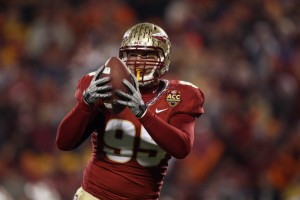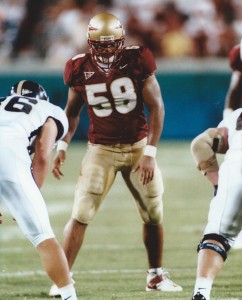In our previous installment of Seminole Stand-Off, we compared two of the greatest linebackers in FSU history to try and answer which one we would want on a team. It was close call, but ultimately Derrick Brooks was the selection for his versatility and added accomplishments from the team. Our readers agreed as Brooks got 53 percent of the vote in our poll. Now we move up to the defensive end position — a spot that has been loaded with talent throughout FSU’s history.
In order to make your mark at defensive end for FSU, you need to go above and beyond what is usually expected of defensive linemen. Quite frankly, this match-up could have had a multitude of other players being compared: Peter Boulware, Andre Wadsworth, and Reinard Wilson are some names that come to mind when one thinks of the position’s history.
While Werner and Reynolds are separated by 11 years, they have very similar career arcs and are both still fondly remembered by Seminole fans, even if they aren’t as accomplished as others. Reynolds was inducted into the FSU Hall of Fame in 2013 and Werner was selected in the first round of the 2013 NFL Draft, so fans will have to wait to truly see how Werner’s legacy grows in the next few years — but that doesn’t mean we can’t compare how each did on the field and their respective impacts while playing for the Seminoles.
The same rules will apply: A player’s NFL career will not be factored into our analysis — we are strictly looking at college performance/legacy. We will attempt to compare players from similar eras as well, meaning you probably won’t see a Fred Biletnikoff vs. Rashad Greene breakdown. Finally, team accomplishments will certainly have a role but we will try to isolate a single player’s impact in order to make it fair.
Jamal Reynolds
As a highly-touted recruit out of South Carolina, Reynolds had tons of promise when he chose FSU as his college destination in 1997. While he didn’t obtain a starting position until his junior year in 1999, Reynolds was still able to fulfill and exceed all expectations on his way to becoming one of the storied defensive ends in Florida State history.
Initially when one looks at his numbers you’d think that he was a 4-year starter. With totals of 170 tackles, 33 tackles for loss, 23.5 sacks, and 4 forced fumbles, it certainly seems that way. As mentioned above however, it was his junior and senior seasons that truly stand out.
After helping complete a perfect season and win a national championship in 1999, Reynolds chose to return for one more year and shock those who thought he might leave and capitalize on a rising NFL draft stock. It worked out pretty well for him: Reynolds was a unanimous All-American and winner of the 2000 Lombardi Award as the nation’s best defensive lineman.
That being said, it can be argued that Reynolds’ best game came at the absolute best time — the Sugar Bowl against Virginia Tech for the 1999 national championship. The Michael Vick-led Hokies had a deadly offense whose speed was very hard to contain. Yet, Reynolds did just that by sacking Vick three times and racking up 6 total tackles — his second most in a game that season. The hyped recruit from South Carolina had finally come into his own and showed everyone just how much he could impact a game.
With Reynolds at defensive end, the Seminoles went 45-5 and appeared in three national championship games, winning only one of them. Reynolds would never play in a non-major bowl game and helped the Seminoles win four ACC titles while he was at Florida State.
Even though his senior season didn’t end how he probably wanted it to, Reynolds knew nothing but success while in college. He was a part of what could be argued as the greatest 4-year stretch in FSU history and has all the rings to show for it.

CHARLOTTE, NC – DECEMBER 04: Bjoern Werner #95 of the Florida State Seminoles against the Virginia Tech Hokies during their game at Bank of America Stadium on December 4, 2010 in Charlotte, North Carolina. (Photo by Streeter Lecka/Getty Images)
Björn Werner
In contrast to the famous recruit he’s matched up against, Björn Werner was never supposed to be a star lineman. Werner came from Berlin, Germany where he says he fell in love with the sport after attending a flag football camp at age 15.
He played two years of high school football in Connecticut as part of an exchange program and was eventually rewarded with a 3-star composite ranking. The raw talent was there — that much was noticeable. But his lack of experience and refinement meant that he was going to be a project player wherever he went.
Turns out the finished product was one of the best linemen of the past 10 years. In three years with the Seminoles, Werner had 99 tackles, 35 tackles for loss, 23.5 sacks, and a defensive touchdown. Keep in mind that he only started for two of those seasons although he played in every game his freshman year as a reserve.
Either way, Werner’s 2012 season with 13 sacks and 42 total tackles vaulted him to a unanimous All-American selection and the award for ACC Defensive Player of the Year. Impeccable instincts and realized talent made Werner a nightmare for offensive lines wishing to protect their quarterback.
Ultimately, the decision to not come back for his senior year has some wondering just how good he could have been. He is still tied for fourth in career sacks at FSU with none other than Jamal Reynolds, who as mentioned above had one more year than him even if Reynolds only played sparingly as a freshman. Werner almost certainly would have passed Ron Simmons and neared Reinard Wilson’s school-record of 35.5 had he came back for another year.
While his FSU team’s only went 31-10 and had only one ACC championship in his career, Werner was an integral part in bringing FSU out of the “Lost Decade” so to speak. His teams won three straight bowls including an Orange Bowl victory over Northern Illinois in 2012 that was the first BCS appearance for Florida State since 2005. He didn’t get to see the success that Reynolds did, but Werner’s individual impact could be argued as being even greater. So is it?
Who’s The Choice?
Part of the problem with choosing guys that have similar career arcs is just that — they have similar career arcs. It’s like trying to choose which pizza to order. There’s no wrong answer, because it’s still pizza. Both guys are even tied in career sacks — one of the key markers of a good defensive end.
In order to give a more accurate statistical context, it should be noted that even though he had one more year than Werner, Reynolds only played in five more games than him (46 to 41). This means it becomes one of the rare instances where we are in fact able to compare volume stats without having to adjust too much.
To give a short summary, Werner beats Reynolds in tackles for loss and interceptions but Reynolds caused more fumbles and dominates Werner in total tackles (170 to 99). Even with the 5-game advantage, that last number differential is hard to get around. Ultimately, it could be attributed to difference in responsibilities like run-stopping or pass-rushing.
Oddly enough, one aspect of Werner’s teams might be the reason Reynolds gets selected over him. If one looks at their teammates and how they performed, Reynolds had less help than Werner did. In Werner’s two years of starting duty, he had teammates Cornellius “Tank” Carradine and Brandon Jenkins combine for 25.5 sacks.
Reynolds had Corey Simon on the inside helping him out, but Simon only had 11 total sacks over his career since he was a defensive tackle. There was also David Warren who had 9 sacks in 2000, but that is still less help than what was given to Werner.
But then the response becomes one of expectations. Werner’s rise to first round draft pick was more surprising than Reynolds’ and overall, the teams were less talented during Björn’s years. These are indeed good points to bring up. Despite this, Jamal Reynolds is ultimately the one that should be chosen for the all-time team.
It’s important to remember that the comparison is still focused on each player in their own right. Over each player’s respective careers, Reynolds had the more impressive list of accomplishments than Werner. It’s probably fair to argue that Werner was a better sack artist but it’s almost impossible to say he had more of an overall impact than Reynolds.
Perhaps Reynolds’ teams really did help him out a bit more…but he certainly took advantage of this in the best way possible. In the one BCS bowl Werner went to, he only had two tackles and no sacks. Compare this to his counterpart’s performance in both the 1999 and 2000 national championships.
This should not be interpreted as a slight on Werner. It’s simply the observations that have to be made when you’re comparing two all-time greats. Think of it not as a criticism of one, but instead the praise of another.
Do you agree with the pick? Let us know on Twitter or Facebook or the comments below. If there’s any match-up you want to see dissected, make sure to mention it as well!





















